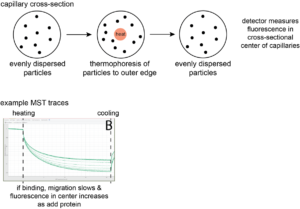MST Guidelines
Background Information
Microscale thermophoresis (MST) is used to determine binding affinities using fluorescently labeled ligands.
Visualize a cross-section of the capillaries, with particles of interest in a solution inside. During an MST experiment, the capillaries have evenly spaced particles within. Infrared light is used to heat the capillary lengthwise down the center. As heat is applied, particles move outwards toward the edges of the capillary. With a loss of heat, particles return again to their evenly dispersed arrangement. The MST detector measures fluorescence in the center of the capillaries.
The labeled particle (DNA) is present at the same concentration in every capillary, so if there is no binding at all, readings will be equal between all samples.
The unlabeled particle (protein) is added to each sample at differing concentrations. If the labeled particle is bound by the unlabeled particle, migration will be slower and dependent on unlabeled particle concentration.

INSTRUMENT BOOKING
New users must receive instrument training before booking instrument time.
To set up instrument training, email Alex Fisch.
Capillary tubes and fluorescent tags are not provided and must be purchased as needed for your experiment. Supplies can be ordered from NanoTemper through their representative:
The Monolith NT.115 (NanoTemper) instrument is located in 5132 MRBIII. To schedule instrument time through the iLab Calendar, use the following instructions:
- Go to https://vanderbilt.corefacilities.org/landing/2191#/cores
- Choose Tab: Vanderbilt Center for Structural Biology Megalab Core
- Sign-in using your VUNet ID
- Choose MST – S10 NanoTemper Monolith NT.115 from the list
- Click View schedule
- Book a desired time in the calendar
- Fill in the information for the payment option
- In case of difficulties contact arina.hadzi@vanderbilt.edu
General Operational Information
The Monolith instrument is equipped with two LED lasers, blue and red, and is good for measurements of the majority of green, blue and red fluorophores with a wavelength within the correct spectrum range:
BLUE – Excitation 465-490 nm; Emission 500-550 nm
RED – Excitation 600-640 nm; Emission 660-725 nm
Consumables can be ordered from NanoTemper, and there are different types of capillaries (standard treat 1000 capillaries cat. no. MO-K002) and labeling kits: https://nanotempertech.com/monolith-consumables/. Each lab/user should order capillaries and labeling kits if needed.
The advantage of microscale thermophoresis is that it uses very small quantities and volumes of material. The capillaries need as little as 4 uL of your sample. Typically, 10-11 uL is the volume loaded when the sample is not limiting.
The analysis allows for the measurement of up to 16 samples together and it takes ~10 minutes to have the analysis completed. For statistical purposes, there needs to be at least 3 repetitions (usually 4) for a standard deviation and error bar calculation.
Microscale thermophoresis is a very sensitive method that allows for the measurement of binding affinities between different components, including proteins, nucleic acids, small molecule compounds and many more (for details visit NanoTemper website). In principle, detection requires one component to be labeled with fluorophore (TARGET) and one unlabeled (LIGAND).
Check before the experiment if the concentration of the unlabeled molecule is high enough to reach a final concentration at least an order of magnitude (ideally even higher) above the expected dissociation constant (Kd). For details refer to the “Concentration Finder” Tool in the Monolith Software.
MST User Guide
To see the complete MST user guide and protocol, click here.

You must be logged in to post a comment.